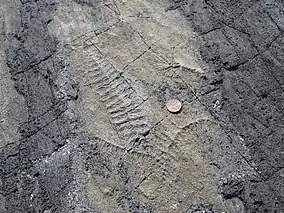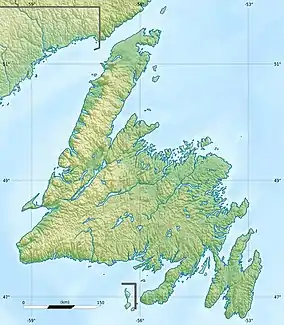Mistaken Point Ecological Reserve
Mistaken Point Ecological Reserve is a wilderness area and a UNESCO World Heritage Site located at the southeastern tip of Newfoundland's Avalon Peninsula in the Canadian province of Newfoundland and Labrador. The reserve is home to the namesake Mistaken Point Formation, which contains one of the most diverse and well-preserved collections of Precambrian fossils in the world. Ediacaran fossils discovered at the site constitute the oldest known remnants of multicellular life on Earth.[2]
| Mistaken Point Ecological Reserve | |
|---|---|
IUCN category II (national park)[1] | |
 | |
  | |
| Location | Newfoundland and Labrador, Canada |
| Nearest city | St. John's |
| Coordinates | 46°37′55″N 53°11′25″W |
| Area | 5.7 km2 (2.2 sq mi) |
| Established | 1984 |
| Governing body | Newfoundland and Labrador Department of Environment and Conservation |
| Official name | Mistaken Point |
| Type | Natural |
| Criteria | viii |
| Designated | 2016 (40th session) |
| Reference no. | 1497 |
| State Party | Canada |
| Region | Europe and North America |
Mistaken Point
Mistaken Point (46°37′32″N 53°09′41″W) is a small headland on the Avalon Peninsula. Historically, Mistaken Point has been mistaken for Cape Race due to the area's typically foggy weather conditions. Sailors making this error would turn north, thinking they had reached Cape Race Harbour, and immediately run into treacherous rocks.
History
The first fossil to be found in the area, Fractofusus misrai, was discovered in June 1967 by Shiva Balak Misra, an Indian graduate student studying geology at Memorial University of Newfoundland.[3][4] In the mid-1980s, the site quickly became recognized as an important location containing possibly the oldest metazoan fossils in North America, and the most ancient deep-water marine fossils in the world. A five kilometre stretch of coastline was first established provisionally as a reserve by the provincial government in 1984 and was permanently designated in 1987. It was later expanded in 2009 after further fossil discoveries.[2]
Fossils
Studies have shown that the Mistaken Point biota represents the oldest Ediacaran fossils known globally, and are the oldest large and architecturally complex organisms in Earth history.[5] The fossil sites along the shore within the reserve were inscribed to the UNESCO World Heritage Sites list on July 17, 2016.[6][7][8]
Avalonia terrane
The fossil terrane of Mistaken Point is the named Avalonian terrane that is found in Western Europe.[9] It formed in the early Cambrian when Pannotia broke from Gondwana-(now South America, Africa, Antarctica, and Australia).
Cultural references
- Prolific Canadian rock band The Tragically Hip include a reference to Mistaken Point in "Fly", the fourth track on their 2006 album World Container. The same track also includes a reference to Moonbeam, Ontario.
- The wreck of the RMS Titanic was found on 1 September 1985, slightly more than 600 km (370 mi) from Mistaken Point.
References
- "Protected Planet | Mistaken Point Ecological Reserve". Protected Planet. Retrieved 2020-10-13.
- "Mistaken Point Ecological Reserve". NL Department of Environment and Conservation. Government of Newfoundland and Labrador. Archived from the original on 11 November 2016. Retrieved 17 July 2016.
- BBC News (18 September 2007). "Rare honour for Indian geologist". BBC South Asia. Retrieved 10 July 2011.
- http://www.mistakenpointfauna.com/paper1.html MISRA, S.B.,(1969a) Geology of Biscay Bay-Cape Race area, Avalon Peninsula, South Eastern Newfoundland
- Queens University Research Archived 17 July 2015 at the Wayback Machine
- "Mistaken Point". UNESCO World Heritage Centre. United Nations Educational, Scientific and Cultural Organization. Retrieved 17 July 2016.
- MacEachern, Daniel. "Newfoundland's Mistaken Point named UNESCO World Heritage site". CBC News. Retrieved 17 July 2016.
- Unesco World Heritage List
- COCKS, L. R. M.; MCKERROW, W. S.; VAN STAAL, C. R. (September 1997). "The margins of Avalonia". Geological Magazine. 134 (5): 627–636. Bibcode:1997GeoM..134..627C. doi:10.1017/s0016756897007425. ISSN 0016-7568.
External links
| Wikimedia Commons has media related to Mistaken Point Ecological Reserve. |
- Official website
- Management Plan, Newfoundland and Labrador, Dept. of Environment and Conservation
- Queens University research
- Discovery of Mistaken Point fauna
- The Origin and Early Evolution of Animals
- Localities of the Vendian: Mistaken Point, Newfoundland